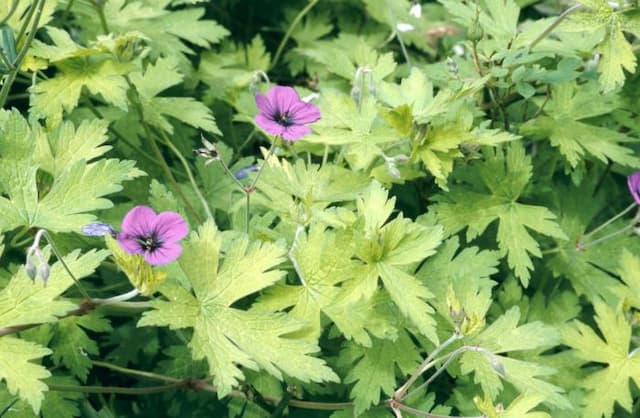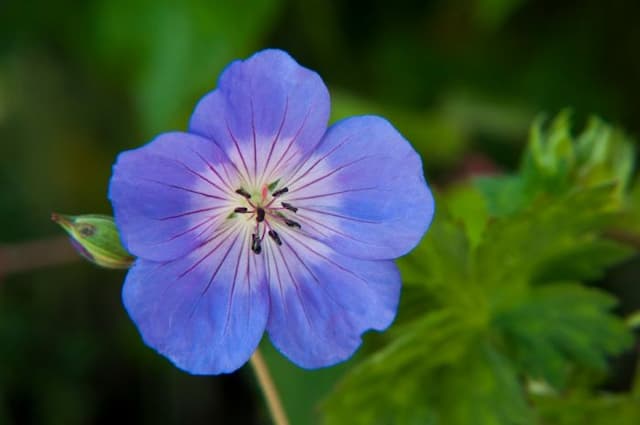Geranium Pelargonium 'Earl of Chester' (Min/d)

ABOUT
Pelargonium 'Earl of Chester' is a distinctive plant known for its ornamental value. It has a bushy and compact growth habit, with a tendency to produce dense foliage. The leaves have a unique appearance, often marked by a zonal pattern that can range from lighter green to darker green hues. These leaves may have a rounded to heart shape, with scalloped or serrated edges, contributing to their decorative quality. The flowers of Pelargonium 'Earl of Chester' are one of its most striking features. They typically come in clusters, called umbels, and can be single or double blooms. The petals are often brightly colored, with shades ranging anywhere from vivid pinks to rich reds, often accented with contrasting darker or lighter markings or streaks. Each petal is rounded, with a soft texture, and may exhibit a slight ruffling at the edges, which adds to the flower's overall allure. In addition to its visual appeal, this plant can also produce a subtle fragrance, which can be noticed when the leaves are gently rubbed or when the plant is in full bloom. This scent varies among different specimens but often has a citrus or rose-like quality that many find pleasant. Pelargonium 'Earl of Chester' is popularly used in containers, hanging baskets, and as bedding plants because of its showy nature and its proclivity for extended periods of blooming. Its colorful and lush appearance makes it a favored choice for gardeners looking to add a splash of vibrant color and texture to their garden spaces.
About this plant
 Names
NamesSynonyms
Earl of Chester Geranium.
Common names
Pelargonium 'Earl of Chester' (Min/d)
 Toxicity
ToxicityTo humans
Geraniums, including the variety known as Pelargonium 'Earl of Chester', are generally considered non-toxic to humans. They are commonly used in gardens and as houseplants. While ingesting parts of the plant is unlikely to cause serious poisoning, it could potentially cause minor symptoms such as nausea, vomiting, or diarrhea if consumed in large quantities. In most cases, ingesting this plant is expected to have minimal consequences for humans.
To pets
Geraniums, of which Pelargonium 'Earl of Chester' is a cultivar, can be toxic to pets, especially cats and dogs. If a pet ingests a part of a geranium plant, they may display symptoms of poisoning which can include vomiting, diarrhea, depression, anorexia, and occasionally dermatitis. The toxicity level is generally considered to be mild to moderate, and while it is not typically life-threatening, it is advisable to keep these plants out of reach of pets and to consult a veterinarian if you suspect your pet has ingested any part of the plant.
 Characteristics
CharacteristicsLife cycle
Perennials
Foliage type
Evergreen
Color of leaves
Green
Flower color
Pink
Height
1-2 feet (30-60 cm)
Spread
1-2 feet (30-60 cm)
Plant type
Herb
Hardiness zones
10
Native area
South Africa
Benefits
 General Benefits
General Benefits- Aesthetic Appeal: Adds visual interest to gardens with its vibrant flowers and ornamental foliage.
- Ease of Care: Requires minimal maintenance and is easy to grow, making it ideal for novice gardeners.
- Drought Tolerance: Can survive with limited watering, suitable for areas with water restrictions or dry climates.
- Seasonal Color: Brings lively colors to a garden, balcony, or indoor space, typically during spring and summer.
- Versatility: Suitable for growing in containers, hanging baskets, and as a bedding plant in garden borders.
- Long Blooming Period: Flowers for a prolonged period, providing color for much of the growing season.
- Attracts Pollinators: Draws in beneficial insects like bees and butterflies, helping to pollinate other plants.
- Deer Resistance: Often not favored by deer, reducing the likelihood of damage in areas with deer populations.
 Medical Properties
Medical Properties- This plant is not used for medical purposes.
 Air-purifying Qualities
Air-purifying QualitiesThis plant is not specifically known for air purifying qualities.
 Other Uses
Other Uses- Craft Projects: The vibrant leaves and flowers of geranium can be used in crafting, such as in making bookmarks, greeting cards, or pressed flower arrangements.
- Natural Fabric Dye: Geranium leaves and petals can be boiled to extract a natural dye for fabrics, providing a range of colors depending on the part of the plant used.
- Aromatherapy: The aromatic oils in geranium leaves are sometimes used in homemade essential oils for aromatherapy practices to create a calming atmosphere.
- Cooking Ingredient: Some geranium leaves are edible and can add a unique flavor to culinary dishes, desserts, and beverages like teas and cocktails.
- Photography: Geraniums can serve as beautiful subjects or backdrops in macro photography or botanical photography due to their intricate details and colors.
- Garden Companions: Geraniums can be planted alongside other plants to help deter certain pests due to their strong scent, acting as a natural pest control.
- Decorative Ice Cubes: Freezing small flowers or leaves in ice cubes can add a decorative touch for events or special drinks.
- Perfumery: The essential oils extracted from geranium can be used as a base note in perfume and cologne creations.
- Education: Geraniums can serve as a tool for educational purposes, teaching children about plant biology and gardening.
- Sachets and Potpourri: Dried geranium leaves and flowers can be included in sachets and potpourri mixes to impart a pleasant fragrance to drawers and closets.
Interesting Facts
 Feng Shui
Feng ShuiThe Scented Geranium is not used in Feng Shui practice.
 Zodiac Sign Compitability
Zodiac Sign CompitabilityThe Scented Geranium is not used in astrology practice.
 Plant Symbolism
Plant Symbolism- Comfort and Healing: Pelargoniums are often associated with feelings of comfort and the nurturing aspect of healing due to their pleasant scent and use in traditional remedies.
- Resilience: As hardy plants that can adapt to various conditions, they symbolize resilience and the ability to endure challenges.
- Friendship: The attractive flowers and overall appearance of the plant can represent warmth and friendliness, making it a symbol of companionship and good relationships.
- Protection: Traditionally, pelargoniums were thought to have protective qualities, being used to ward off evil spirits when planted around the house.
 Water
WaterThe Scented Geranium, commonly referred to by its cultivar name 'Earl of Chester', requires watering when the top inch of soil feels dry to the touch. Depending on the environment, this could mean watering approximately every 7 to 10 days. Use room temperature water and gently pour it around the base of the plant until water starts to drain from the bottom of the pot. Typically, using about 8-16 ounces of water per session should be sufficient. During winter or in cooler temperatures, water less frequently to prevent root rot.
 Light
LightScented Geraniums require bright, indirect sunlight to thrive. A spot near a south-facing window with some partial shade, especially during the hottest part of the day, is ideal. Avoid placing your 'Earl of Chester' in full, direct sunlight as this can scorch the leaves.
 Temperature
TemperatureScented Geraniums prefer a temperature range between 65°F and 75°F during the day, and they can tolerate a slight drop at night, but should not be exposed to temperatures below 55°F. The ideal temperature for the 'Earl of Chester' is around the upper end of this range, ensuring healthy growth.
 Pruning
PruningPrune your Scented Geranium to shape the plant, encourage bushier growth, and remove dead or yellowing leaves. Pruning is best done in the early spring before new growth begins. Cutting back the plant by one-third is a good rule of thumb, and regular pinching of the tips during the growing season will help maintain its shape.
 Cleaning
CleaningAs needed
 Soil
SoilGeranium 'Earl of Chester' prefers well-draining soil mix with added perlite or sand for aeration; an ideal pH range is 6.0-7.0.
 Repotting
RepottingGeranium 'Earl of Chester' should be repotted every 1-2 years or when it outgrows its current pot.
 Humidity & Misting
Humidity & MistingGeranium 'Earl of Chester thrives at average room humidity levels; avoid excessively dry or humid conditions.
 Suitable locations
Suitable locationsIndoor
Place Geranium 'Earl of Chester' in bright, indirect sunlight indoors.
Outdoor
Grow Geranium 'Earl of Chester' in full sun to partial shade outdoors.
Hardiness zone
10-11 USDA.
 Life cycle
Life cycleThe life cycle of Pelargonium 'Earl of Chester', commonly known as Zonal Geranium, starts with seed germination, which requires light, warmth, and moisture, and usually takes about 7 to 14 days. Following germination, the seedlings grow through a vegetative stage where leaves and stems develop; during this period, the plant should be provided with plenty of light to avoid legginess. As the plant matures, it enters the flowering stage, producing vibrant blooms that can be red, pink, white, or purple, depending on the variety, and this stage can be prolonged with proper deadheading and care. After flowering, if seeds are allowed to develop, they will mature and can be collected for propagation, although many cultivars, including 'Earl of Chester', are often propagated through cuttings to maintain the characteristics of the parent plant. In temperate climates, Zonal Geraniums are treated as annuals and will die with the first frost, but in warmer climates or when protected from the cold, they can survive as perennials and may enter a period of dormancy during cooler months. Throughout its life cycle, regular feeding, proper watering, and pest management are crucial for the health and longevity of the plant.
 Propogation
PropogationPropogation time
Spring-Early Summer
Pelargonium 'Earl of Chester', commonly known as a type of Geranium, is often propagated through stem cuttings. The ideal time for this is in the late spring to early summer when the plant is actively growing. To propagate, a healthy, disease-free stem about 4-6 inches (10-15 centimeters) long is cut just below a node, where a leaf joins the stem. The lower leaves are removed, and the cut end can be dipped in rooting hormone to encourage root growth. The cutting is then placed in a pot with well-draining potting mix, ensuring that at least one node is below the surface. It is important to keep the soil moderately moist but not waterlogged, and the pot should be kept in a warm, brightly lit area but out of direct sunlight until roots have developed, which typically takes a few weeks. Once rooted, the new plant can be potted up and treated as an adult plant.









